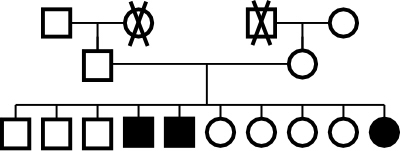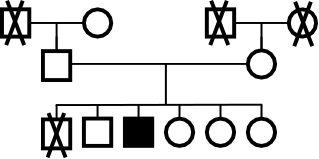Useful Research Families
Ned Patterson, DVM
University of Minnesota, College of Veterinary Medicine
Most owners and breeders are accustomed to looking at pedigrees that focus on an individual dog and it's ancestors. Geneticists look at entire family groups to compare the genotype (DNA) and phenotype (visible traits) of closely related individuals.
Research Pedigree Example

As this example shows, males are represented by squares and females by circles, with black fill for affected animals and open shapes for normal individuals.
All pedigrees with at least one affected individual are useful. In general, more genetic information is generated by more affected individuals, and more affected generations.
Ideal Research Family Pedigree

A pedigree with affected individuals in more than one generation is the ideal family for genetic research. A family with one affected parent, and more than one affected offspring yields at least 6 times more genetic information than a family with a single affected individual.
In this family, the affected and the non-affected offspring are equally important for research - all siblings should be sampled if possible.
Very Useful Research Family Pedigree

A family with multiple affected offspring from non-affected parents is also very useful. As with the previous example, try to sample all living family members.
Useful Research Family Pedigree

This family has only one affected individual, and fewer living family members. While this does not give researchers as much information as the previous two examples, there is useful information to be gained by sampling these dogs.
We are interested in samples from any pedigree with an affected individual.